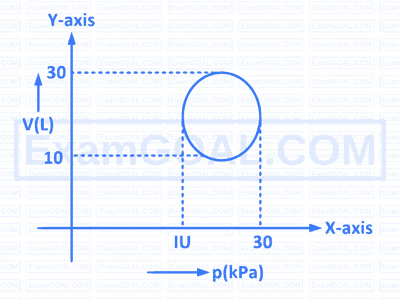Heat and Thermodynamics · Physics · AP EAPCET
MCQ (Single Correct Answer)
Water of mass $m$ at $30^{\circ} \mathrm{C}$ is mixed with with 5 g of ice at $-20^{\circ} \mathrm{C}$. If the resultant temperature of the mixture is $6^{\circ} \mathrm{C}$, then the value of $m$ is (specific heat capacity of ice $=0.5 \mathrm{cal} \mathrm{g}^{-10} \mathrm{C}^{-1}$, specific heat capacity of water $=1$ calg ${ }^{-1}{ }^{\circ} \mathrm{C}^{-1}$ and latent heat of fusion of ice $=80 \mathrm{cal} \mathrm{g}^{-1}$ )
The total internal energy of 2 moles of a monoatomic gas at a temperature $27^{\circ} \mathrm{C}$ is $U$. The total internal energy of 3 moles of a diatomic gas at a temperature $127^{\circ} \mathrm{C}$ is
A metal ball of mass 100 g at $20^{\circ} \mathrm{C}$ is dropped in 200 g of water at $80^{\circ} \mathrm{C}$. If the resultant temperature is $70^{\circ} \mathrm{C}$, then the ratio of specific heat of the metal to that of water is
Initially the pressure of 1 mole of an ideal gas is $10^5 \mathrm{Nm}^{-2}$ and its volume is 16 L . When it is adiabatically compressed, its final volume is 2 L . Work-done on the gas is
$\left[\right.$ molar specific heat at constant volume $\left.=\frac{3}{2} R\right]$An ideal gas is taken around $A B C A$ as shown in the $P^{\prime \prime}$ diagram. The work done during the cycle is

The ratio of kinetic energy of a diatomic gas molecule at a high temperature to that of NTP is
Match the following ( $f$ is number of degrees of freedom)
$$ \begin{array}{llll} \hline& \text { Gases } & & \frac{C_p}{C_v} \text { value } \\ \hline \text { A } & \text { Monoatomic } & \text { I } & \frac{4+f}{3+f} \\ \hline \text { B } & \text { Diatomic (rigid) } & \text { II } & \frac{5}{3} \\ \hline \text { C } & \text { Diatomic (non-rigid) } & \text { III } & \frac{7}{5} \\ \hline \text { D } & \text { Polyatomic } & \text { IV } & \frac{9}{7} \\ \hline \end{array} $$Heat energy absorbed by a system going through the cyclic process shown in the figure is

| (a) Thermal conductivity | (i) $\left[\mathrm{MLT}^{-3} \mathrm{~K}^{-1}\right]$ |
| (b) Boltzmann constant | (ii) $\left[M^0 L^2 T^{-2} K^{-1}\right]$ |
| (c) Latent heat | (iii) $\left[M L^2 T^{-2} K^{-1}\right]$ |
| (d) Specific heat | (iv) $\left[M^0 L^2 T^{-2}\right]$ |
5 g of ice at $$-30^{\circ} \mathrm{C}$$ and 20 g of water at $$35^{\circ} \mathrm{C}$$ are mixed together in a calorimeter. The final temperature of the mixture is (Neglect heat capacity of the calorimeter, specific heat capacity of ice $$=0.5 \mathrm{cal} \mathrm{g}^{-1}{ }^{\circ} \mathrm{C}^{-1}$$ and latent heat of fusion of ice $$=80 \mathrm{cal} \mathrm{g}^{-1}$$ and specific heat. capacity of water $$=1 \mathrm{cal} \mathrm{g}^{-1}{ }^{\circ} \mathrm{C}^{-1}$$)
An iron sphere having diameter $$D$$ and mass $$M$$ is immersed in hot water so that the temperature of the sphere increases by $$\delta T$$. If $$\alpha$$ is the coefficient of linear expansion of the iron then the change in the surface area of the sphere is
The work done by a Carnot engine operating between 300 K and 400 K is 400 J. The energy exhausted by the engine is
The slopes of the isothermal and adiabatic $$p-V$$ graphs of a gas are by $$S_I$$ and $$S_A$$ respectively. If the heat capacity ratio of the gas is $$\frac{3}{2}$$, then $$\frac{S_I}{S_A}=$$
The number of rotational degrees of freedom of a diatomic molecule
A metal tape is calibrated at $$25^{\circ} \mathrm{C}$$. On a cold day when the temperature is $$-15^{\circ} \mathrm{C}$$, the percentage error in the measurement of length is
(Coefficient of linear expansion of metal $$=1 \times 10^{-5}{ }^{\circ} \mathrm{C}^{-1}$$)
A gas is expanded from an initial state to a final state along a path on a $$p$$-$$V$$ diagram. The path consists of (i) an isothermal expansion of work 50 J , (ii) an adiabatic expansion and (iii) an isothermal expansion of work 20 J . If the internal energy of gas is changed by $$-$$30 J , then the work done by gas during adiabatic expansion is
The temperature of the sink of a Carnot engine is 250 K . In order to increase the efficiency of the Carnot engine from $$25 \%$$ to $$50 \%$$, the temperature of the sink should be increased by
In non-rigid diatomic molecule with an additional vibrational mode
A sphere of surface area $$4 \mathrm{~m}^2$$ at temperature 400 K and having emissivity 0.5 is located in an environment of temperature 200 K. The net rate of energy exchange of the sphere is (Stefan Boltzmann constant, $$\sigma=5.67 \times 10^{-8} \mathrm{Wm}^{-2} \mathrm{~K}^4)$$
A Carnot engine operates between a source and a sink. The efficiency of the engine is $$40 \%$$ and the temperature of the sink is $$27^{\circ} \mathrm{C}$$. If the efficiency is to be increased to $$50 \%$$, then the temperature of the source must be increased by
A car engine has a power of 20 kW. The car makes a roundtrip of 1 h. If the thermal efficiency of the engine is $$40 \%$$ and the ambient temperature is 300 K . The energy generated by fuel combustion is
The number of vibrational degree of freedom of a diatomic molecule is
Boiling water is changing into steam. The specific heat of boiling water is
If the volume of a block of metal changes by $$0.12 \%$$ when heated through $$20^{\circ} \mathrm{C}$$, then find its coefficient of linear expansion.
Isothermal process is the graph between
For a monoatomic ideal gas is following the cyclic process ABCA shown in the U versus p plot, identify the incorrect option.

The pressure of a gas is proportional to
Expansion during heating
Match the following.
| Column I | Column II | ||
|---|---|---|---|
| (A) | Ratio of change in time-period of a sample pendulum with temperature to its original time period | 1. | $$\alpha \Delta T$$ |
| (B) | Ratio of the value of a length to its scale reading | 2. | $$T$$ |
| (C) | Reciprocal of coefficient of volume expansion for an ideal gas of constant pressure | 3. | $$(1+\alpha\Delta T)$$ |
| (D) | $$\frac{F}{YA}$$ | 4. | $$\frac{1}{2}\alpha\Delta T$$ |
Which of the following is not a reversible process?
Which one of the graphs below best illustrates the relationship between internal energy U of an ideal gas and temperature T of the gas in K?
A refrigerator with coefficient of performance 0.25 releases 250 J of heat to a hot reservoir. The work done on the working substance is
A vessel has 6 g of oxygen at pressure p and temperature 400 K. A small hole is made in it, so that oxygen leaks out. How much oxygen leaks out if the final pressure is p/2 and temperature is 300 K?
In a steady state, the temperature at the end $$A$$ and end $$B$$ of a $$20 \mathrm{~cm}$$ long rod $$A B$$ are $$100 \Upsilon$$ and $$0^{\circ} \mathrm{C}$$. The temperature of a point $$9 \mathrm{~cm}$$ from $$A$$ is
If two rods of length $$L$$ and $$2 L$$, having coefficients of linear expansion $$\alpha$$ and $$2 \alpha$$ respectively are connected end-to-end, then find the average coefficient of linear expansion of the composite rod.
A system is taken from state-A to state-B along two different paths. The heat absorbed and work done by the system along these two paths are Q$$_1$$, Q$$_2$$ and W$$_1$$, W$$_2$$ respectively, then
A gas ($$\gamma$$ = 1.5 ) is suddenly compressed to (1/4 )th its initial volume. Then, find the ratio of its final to initial pressure.
A cylinder has a piston at temperature of $$30 \Upsilon$$C. There is all round clearance of $$0.08 \mathrm{~mm}$$ between the piston and cylinder wall if internal diameter of the cylinder is $$15 \mathrm{~cm}$$. What is the temperature at which piston will fit into the cylinder exactly?
$$\left(\alpha_p=1.6 \times 10^{-5} / \Upsilon\mathrm{C} \text { and } \alpha_c=1.2 \times 10^{-5} / \Upsilon\mathrm{C}\right)$$
A balloon contains 1500 m$$^3$$ of He at 27$$\Upsilon$$C and 4 atmospheric pressure, the volume of He at $$-3\Upsilon$$C temperature and 2 atmospheric pressure will be